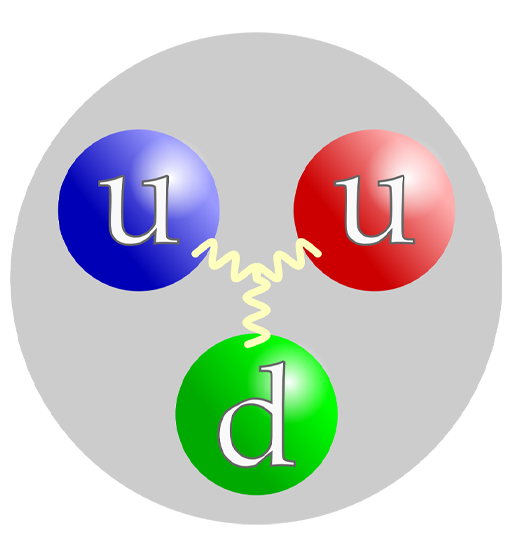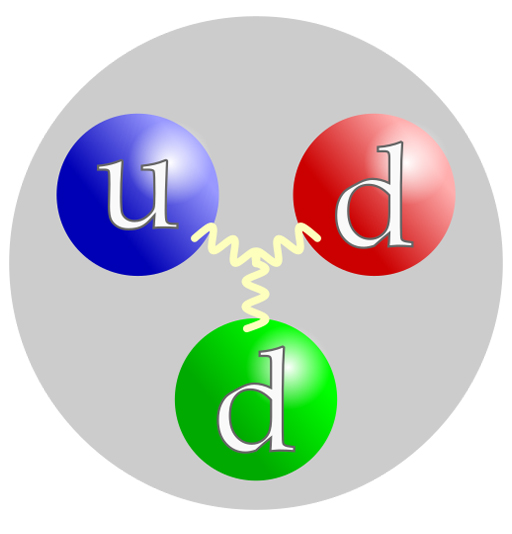3.2 Quarks
Gell-Mann’s model stipulated that hadrons were in fact composite particles, consisting of what are now known as quarks (this name was apparently inspired by the line ‘Three quarks for Muster Mark’ in James Joyce’s 1939 novel Finnegans Wake). There are three different types – often referred to as ‘flavours’ – named u (‘up’), d (‘down’) and s (‘strange’).
Each quark also has its own antiparticle, denoted in writing by a bar, giving us three antiquarks: , and . These quarks have unusual properties. While all hadrons have whole numbers of electric charge, quark electric charges are +2/3 for the up quark and -1/3 for the down and strange quarks. The antiquarks have opposite charges, so that’s -2/3 for , and +1/3 for and . Here are some examples to demonstrate these numbers.
A proton has electric charge of +1, and it consists of three quarks: two up quarks and one down quark. So, it can be represented as uud. Note that you can easily check the maths here: 2/3 + 2/3 - 1/3 = 1.
The neutron has no charge, and it too consists of three quarks: one up quark and two down quarks. So, it can be represented as udd. Adding up the charges, you find the expected result here too: 2/3 - 1/3 - 1/3 = 0.
The up and down quarks are the two quarks with the smallest mass and make up all the natural nuclear matter on earth.
Protons and neutrons are examples of ‘baryons’, a term which refers to particles consisting of three quarks. Their antiparticles, which contain three antiquarks, are known as ‘antibaryons’. In addition to these, there are also hadrons of a different composition, which are called ‘mesons’. They are made from a quark and an antiquark.
While symmetry played a significant role in detecting the pattern and deriving the model, the symmetry is in fact not perfect, because the three quarks have different masses. So, changing the quark content (a ‘transformation’ akin to the rotation of the triangle earlier) changes the mass of a particle (so the properties are not exactly the same as before).
But that’s not all! More particles were soon found which revealed additional quarks. The current quark model describes a total of six different flavours. There are the three that have been mentioned, plus: b (‘bottom’ or ‘beauty’), c (‘charm’) and t (‘top’) quarks.
The six quarks are organised into two groups: the u, c and t quarks have electric charge +2/3, while the d, s and b quarks have charge -1/3. In addition, they all have their own antiquarks, so there are already 12 fundamental constituents here. Remember too, that quarks only account for the hadrons, not for any other types of particles such as leptons (the electron being the most familiar example). Even in terms of these basic constituents, nature appears to be rather complex!
The optional interactive below allows you to explore the world of hadrons further, by combining quarks into baryons, antibaryons and mesons. It details their electric charge, as well as the quantities known as strangeness and charm.
You may be wondering why quarks always appear in baryons, antibaryons and mesons, and you don’t observe other combinations, such as particles made up of two quarks. This explanation lies in the force that acts between these particles, as you will learn about next.


